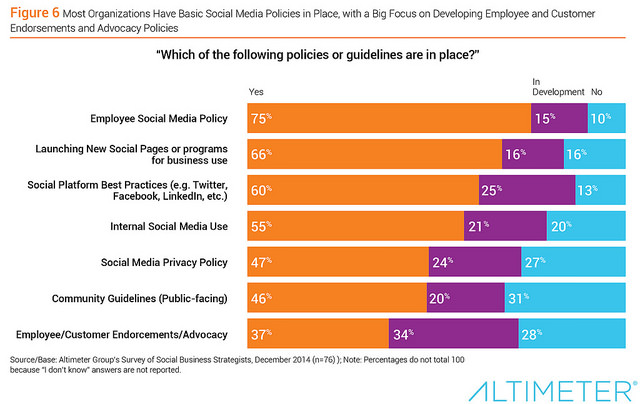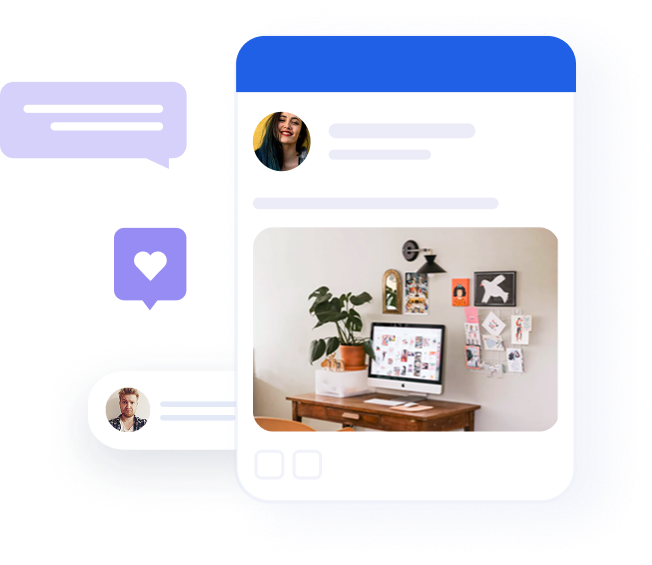A practical employee advocacy guide for business services

Table of contents
In today’s media-saturated world, it’s never been easier for businesses to get their message out to a broad audience. At the same time, the proliferation of voices and platforms has made capturing and holding that audience’s attention more challenging than ever. For some industries, the challenge goes beyond merely standing out from the crowd.
Business services firms can share the expert voices of their partners and associates. People trust their experts; it is all about their knowledge, expertise, and experience.
One practical approach many firms find compelling is employee advocacy—letting your employees promote the company on social media through their unique expert voices and perspectives. An employee advocacy approach can help personalize a company’s image, reach new audiences, and build loyalty and rapport. Advocacy posts reinforce your brand and domain expertise and can be utilized as an internal communication channel that fosters stronger employee engagement.
Social advocacy vs. Social advertising
Why bother with employee advocacy campaigns when you can buy ads on social or sponsor content simply and directly?
Internet users are savvier than ever. Audiences have developed powerful instincts regarding identifying advertising and tuning it out. Individualized content that reflects the poster’s actual feelings and opinions can bypass those automated mental defenses and reach even the most jaded readers.
Let’s take the example of Capco, a business and technology consulting firm. Several years ago, Capco ran its first global brand and recruitment campaign to recruit new talent. For this campaign, their KPI was the number of new applicants they pulled in. The campaign aimed to distribute identical content across LinkedIn, Facebook, and Twitter. Half was organic content, and the other half was paid advertising. Then, they compared the results from both campaigns.
The paid campaign had a 3.93% conversion rate. The organic campaign? 51.7%. Content shared organically by Capco employees was more than twelve times as effective as the paid advertisements.
The compliance hurdle
Companies in heavily regulated industries like finance face more potential complications. According to a study by Putnam Social Advisors, 64% of financial advisors report avoiding posting on social media due to compliance concerns. (Better to be safe than sorry.)
How does a business services company overcome the compliance hurdle when implementing an employee advocacy campaign? First, by remembering that regulations aren’t a gag order; and secondly, you can stay on the right side of compliance by building it into your process, as in this six-step example:
- Establish a social media team
- Create work processes with the compliance team
- Conduct compliance training and leave an open channel for feedback
- Prepare libraries of pre-approved content
- Adopt technology that supports compliance
- Define a crisis management protocol
The last step is an important one. Social media moves fast, and a poorly worded or problematic post can spread to a vast audience in moments. It’s not enough to delete an offending post and expect the internet to move on. You must have a protocol to regain control of your messaging.
A good crisis protocol should involve: monitoring through social media listening tools; reviewing and assessing posts that garner undesirable reactions; responding to questions or criticisms as needed; and finally, resuming a monitoring stance and restoring normal activities.

6 steps to kick-start your employee advocacy program
If you’re ready to launch an employee advocacy program, here are the steps you can take to set your program up to succeed.
Step 1: Establish Program Goals & KPIs
All campaigns are not the same. They vary in what they try to achieve and how their success can be measured. From the outset, it is essential to be clear what you’re trying to do with your employee advocacy campaign and what metrics to analyze. Some examples:
- Goal: Grow brand awareness and engagement
KPIs: Reach, impressions, clicks - Goal: Garner more qualified leads
KPIs: Conversions, MQLs - Goal: Increase sales
KPIs: SQLs, new business - Goal: Recruit new talent
KPIs: Qualified applicants

Step 2: Identify your content strategy
There’s no reason to adopt a shoot-from-the-hip plan for sharing and posting content when optimizing engagement in so many ways is already a solved problem.
Your content strategy should be based around the three E’s: Educate, Enlighten, and Entertain your readers. Content should align with employee preferences—their genuine sincerity and enthusiasm are the magic ingredients.
It’s also a good idea to stick to the 4-1-1 rule: for every self-promoting post you make to a social media platform, you should repost one relevant post and share four links to content written by others. This helps readers see your social media presence as a source for thought leadership and interesting articles, not just a 24/7 sales pitch.
Segment your content by topic categories to help readers find content that’s most relevant to their interests. Don’t forget to include rich media—audio or video. Posts with rich media content typically generate four times the engagement of posts with none.
Step 3: Choose your initial advocates
Who is going to lead your employee advocacy campaign? Start with the digital natives in your workforce who feel the most at home participating, sharing, and engaging on social media—the “social enthusiasts”. They’ve already internalized many rules of creating engaging social media content, and they’re not shy about putting it out there. They’re your vanguard—but don’t stop there. A strong employee advocacy campaign can’t solely rest on the backs of the employees already champing at the bit to start posting.
Employees in customer-facing departments also need to be drafted. They’re the ones your customers are already engaging with, who may already have a known online or public presence. As such, they may already have built some trust and goodwill with people engaging with your brand online, which makes them excellent messengers.
Lastly, and perhaps most importantly, is getting the C-suite executives involved. Their participation sets an example for everyone else in your company. Executive statements on specific topics will carry more weight with a general readership. An employee advocacy campaign that doesn’t include the executive tier leaves some of its most potentially influential voices on the table.

Step 4: Illustrate value to employees
Employees not in the “social enthusiasts” group may balk at becoming brand ambassadors for your company online. The last thing you want is a campaign that feels forced or canned. The best way to generate real employee motivation on the project is to demonstrate the value these campaigns can bring to their careers and reputation.
By serving as prominent voices in an educational and attention-grabbing social media campaign, employees can gain engagement and following that can be developed into a thought leadership platform. On a less ambitious scale, their participation will help create professional networking opportunities to help them grow their careers.
Step 5: Run a pilot program
Your first employee advocacy campaign doesn’t have to be a huge-scale undertaking where you’re playing for all the marbles. A small pilot program can be a very effective way to test out your team’s social media acumen, see what strikes a chord with your audience, and what falls flat.
For your initial foray into employee advocacy, you’ll want to provide employees with training and best practices for their social media activities, establish compliance policies, and solicit employee feedback at every step.
As your pilot program progresses, you must track its progress along the relevant performance indicators. With this data, you can do a full review at the program’s end to evaluate its effectiveness and determine what changes to make as you plan the next campaign.
Step 6: Gain leadership buy-in
You’ll want to demonstrate positive results from your pilot program to get full support for employee advocacy campaigns at the highest levels of your company, including, hopefully, the participation of the C-suite execs in your next campaign.
You should be able to present your KPIs in a report that shows a positive ROI resulting from the employee advocacy program. If they don’t, it’s possible that the details of the program need tweaking. It’s also essential to ensure that the KPIs you’re measuring are the most relevant and appropriate for the goals your program is attempting to achieve.
Employee advocacy is not a one-time set-up
It’s often helpful to think of employee advocacy in terms of discrete, goal-oriented campaigns to measure their effectiveness and the value they provide to the company. However, it’s best to consider it a continuous, ongoing process rather than a singular, time-delimited project.
Keep your team ready for the next campaign, whenever it launches, by incentivizing and encouraging employee engagement, holding regular social media training sessions, and seeking employee feedback. At the same time, keep measuring results and optimizing procedures and strategies as the social media landscape shifts and new information comes in.
With these strategies, you can use the powerful employee advocacy tool to benefit your business.




